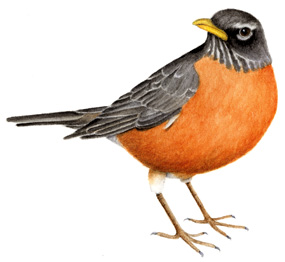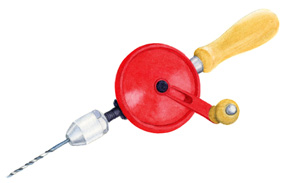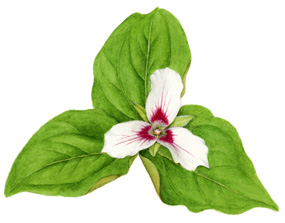
Illustration by Sam Manning.
—Anne Dudley Bradstreet
Dear Friends:
Often April is more like March in these parts—mostly gray and gloomy. Then, like a ray of light, Easter Sunday fills the churches to overflowing with elders, and families and children, and great music. Next day, the ice is gone from the harbor at the head of the bay and the red-winged blackbirds are trilling their “Hallelujahs” from the tree tops. The day after that, high, wavering Vs of calling Canada geese are winging northeastward along the coast, voicing sounds too deep for words, melting the cold around my heart and bringing a lump to my throat and tears to my eyes. Elver nets are strung along the mill brook in response to the deep, ancient cycle of the seasons that calls the tiny, glassy eels to their destinations far upstream. These are reminders that God’s ways and our ways are sometimes as distant as the heavens and the earth. These are signs of the coming liberation of all of us from our crowded houses and our crowded minds.

Illustrations by Candice Hutchinson [4].
Of course, the heavens and the earth do come together, especially in April when it’s sometimes hard to tell the one from the other. The sky, the earth, and the water all seem to flow together, unified by rain, squall or fog, like the Spirit moving over the face of the waters on the first day of Creation to breathe life into the formless void.
Field and forest report, early April
Buds are swelling on the forsythia and red maples, among the first to come into bloom. Green sprouts of daylilies and daffodils are peeking up out of the frosty ground. Flocks of blackbirds, including starlings, grackles, cowbirds and redwings, are flying in formation and landing together to check each other out like teenagers at a sock hop before they pair up for the mating season. Ducks are scouting far and wide for sheltered nesting places close to the water. Mourning doves are billing and cooing on the branches. Robins are clucking about and cocking their heads, looking for slow, cold worms where the snow is gone. As the weather warms and the snow melts, the pruning of fruit trees proceeds. You can safely prune until the green begins to show on your trees, around the beginning of May. You have only a few weeks left, so hop to it.
Natural events, early April
Our loyal, green housemates of some 20 winters are eight potted geraniums: pink, red, lavender, and even one called “Martha Washington,” though I can’t quite remember which one is Martha. Geraniums are often scorned as low-brow and boring (even by me, I admit), but these eight stalwarts have earned my utmost respect. Consider what these elderly flora have to endure at their advanced age.
First of all, I am their primary care-giver. When our daughter Sarah was in college and still knew everything, she would walk into our house, look around and say, “You guys are running a torture chamber for plants here!” I took that to heart and have been trying to do better ever since. Still, it’s fortunate that geraniums are hardy. Their regimen is this:
Around the first fall frost, I cut them back, bring them in from the porch, and set them on the wide window sills. I water and dead-head at least twice a week, and rotate them to the light. Some get bushy, others leggy. This year one sent up a single shoot like Jack’s beanstalk halfway to the ceiling. It seems we are taking better care of each other as the years go by.
Most of the lovely ladies blossom heavily all winter with little more than a good drink of water and some kind words now and then. They look so happy against the snow outside the window, maybe knowing they have it better than their outdoor cousins. Now that the days are warming up, they’re likely dreaming about their annual spring migration to the front porch with a good pruning and some fresh compost added to the pot. I wouldn’t be surprised to wake in the night to the sound of geraniums scratching at the door wanting to go out.
“Not yet my lovelies, not yet. Have another drink.”

Outside the windows, sharp-pointed shoots of green are valiantly piercing the frosty soil: crocuses, daffodils, irises, daylilies, and others of the species
allium are proving that a harsh Maine winter could not kill them. These bulbs are remarkable parcels of indomitable life. Buried in the dark frozen ground and with no eyes to see, still they know their time for rising. I left half a bulb of onion in the cold, dark refrigerator weeks ago and found it again this week. (Maybe you have a fridge like this, too.) The slashed and imprisoned onion had sent out two vigorous green sprouts seeking the light. What generative power! What a tenacious hold on life! It’s no wonder that another
allium, the Easter lily, is the ancient symbol of resurrection.
Natural and un-natural events
There was a time when nearly all the earth’s fresh water was drinkable. Pure, public water supplies are a foundation of all civilizations. Cities and empires grew up beside good waters. Rivers and streams fostered villages and farms. People drank and washed without a second thought. Two hundred years ago there were few polluted waters anywhere on the planet.
Sadly, few of us today would think of drinking from any natural body of water. Bottled water—most of it no better than tap water—is a huge commercial enterprise, and the buying and selling of it is a growth industry worldwide. The water wars have begun. Industrial corporations polluted the earth’s free-flowing fresh water, which once belonged to us all, and now industrial corporations filter it, bottle it, sell it back to us, and leave us to dispose of all those plastic bottles.
What to do? Five things:
First and foremost, don’t be afraid of your own tap water. It’s probably as good as anything you can buy at the store. If you are not sure it is safe, get a simple charcoal filter apparatus at the drugstore and use it. Carry your drinking water in a clean glass bottle inside a mitten or a clean sock to protect and insulate it. If your tastes are more exotic, add a touch of lemon and raw sugar or honey.
Second, identify and make known sources of free-flowing, drinkable water in your neighborhood. How? By talking to your neighbors, especially the old-timers. Most of our towns have a number of springs and other traditional water sources.
Third, remember that pure water is a gift from the heavens. Our 200-year-old house has a huge cistern in the basement that was once fed by down-spouts from the roof. Others of our ancestors counted on the rain barrel to get the freshest drinking and washing water.
Fourth, urge your local legislators to end the control of traditional public drinking water sources by the state. Too many have been shut down by misguided state regulations. They’d do a lot more good fixing state roads and bridges.
Fifth, support CARE and UNICEF and other NGOs as they fight to provide drinkable water worldwide. Good water is a basic human right. It is our Mother’s milk.
Field and forest report, early May
Geysers of sweet sap surging up from the roots of the red maples and American elms have fed and unfurled tiny blossoms, which are now being pushed off by emerging seeds and leaves. You may find the carmine-red flowers of the maples and the soft, mustard-colored elm catkins on the ground underfoot or all over your parked car these days. The Norway maples and the lilacs are showing their green blossom clusters. Meanwhile, the oaks and the ashes—as always—are far behind, still sound asleep.
And then there are the dandelions...
Ma’s Dandelion Wine
3 quarts dandelion blossoms
4 quarts water
3 lbs. sugar
2 medium oranges
2 lemons
1 package dry yeast
1 handful of raisins
Put blossoms in crock. Boil the water and pour over them. Let stand for three days. Stir each day. Strain water into a non-reactive pot. Add sugar, etc. Simmer for an hour. Add raisins. Cover and cool. Add yeast. Cork lightly for six months. Drink.
Mountain report, early May
Tiny bluets or “Quaker ladies” and purple and white violets are in bloom in what the writer Mary Ellen Chase called the “high meadows.” On higher, rockier slopes, the curled spears of Canada mayflower leaves are pointing up and unrolling to reveal tiny green clusters of buds. The many-bladed circular lupine leaves rise aloft on purple stems. Overhead, turkey vultures float silently on the warm updrafts over the south slope of Awanadjo, “small misty mountain” in Algonkian.
Natural events, mid May
We are now at about 14 and a half hours of daylight in these parts, about the same as the first of August, and so it has been since time immemorial. The moon regulates the tides. The movement of the earth regulates the seasons, determining when creatures will mate, give birth, and let their young go free, and when the plants will bloom and go to seed to provide food for all the animals. We can go against these regular rhythms if we wish, but to do so is costly and even disastrous. That is because we are all part of a great self-regulating system that has evolved to provide enough, but not too much, for everyone. It’s called Nature. Nature regulates all things so that all life can continue to thrive and survive.
Field and forest report, mid May
The covering scales tear apart and fall as the flower buds burst forth. The blossoms explode and then fall. The leaves stretch and spread outward. The ground breaks as sprouting seeds push up through the crust. Does all this tearing and bursting and pushing and stretching and breaking hurt? How could it not? Does it bring ecstasy to flower and folk alike? How could it not?
Natural events, late May
In my lifetime, hand tools have largely given way to power tools. The hand drill and brace-and-bit gave way to the electric drill; the crosscut saw and ax to the chainsaw; the broom and rake to the noisy power broom and the leaf blower; the scythe and the push mower to the bush hog and the power mower.
All agriculture and construction until about 150 years ago was carried out with hand tools and a little help from the animals. The great cathedrals and cities of Europe and the tall-steepled churches and towns of New England were built with hand or water or ox power. I hope we haven’t forgotten how to do that.
As an experiment last year at this time, I decided to get the lawn and flower gardens in our dooryard back into shape using only hand tools. It was pleasant on a beautiful day to do all this and still hear the birds singing the whole time.
The soft whir of the old-fashioned reel mower took me back to my youth when I could mow the lawn and listen to a Brooklyn Dodgers game on the radio at the same time. The chunk of the spade and the hoe in the ground, the smell of cut grass and soil instead of oily smoke, were deeply satisfying.
You can still buy decent hand tools for just about every job at your hardware store, though I haven’t seen a good, new, two-man saw in ages. You can still watch the ox and horse pulls at the fairgrounds, and even watch several local farmers working happily and naturally with horses around here, say at Carding Brook, Stoneset, and Horsepower farms.
There is a comforting intimacy with the natural world in working with those old hand tools. You can control them more carefully. You can avoid chopping up the earthworms and mow around the wildflowers better. No goggles or ear-protectors are needed. With power tools you’re putting up one more wall of hostility between yourself and the rest of Creation, driving off the birds with noise and smelly smoke, and annoying your human neighbors.

Slim, slate-gray catbirds return from somewhere south with their sharp mewing call and their sweet imitations of other songs and sounds. Shadbush and wild cherry are in bloom, and early apples are showing pink. Pear trees are just coming into bloom here. Tiny half-inch-long tent caterpillars have emerged and begun weaving their webs in the crotches of smaller branches of fruit trees.
If you have small fruit trees infested by tent caterpillars, the best treatment is to scrape out the web in the cool of the evening or early morning when all the caterpillars are inside and then crush it thoroughly underfoot. Eeew. Best not to put this off too long. In a couple of weeks these hungry larvae can grow up to 2½ inches long and strip a small tree of new leaves.
A walk in the woods on Lower Patten Pond reveals to the wondering eye clusters of rare and delicate trillium in bloom. Nearby, spears of blue flag rise from the mud, and rhodora, New England’s wild azalea, is covered in shocking pink blooms. Ox-eye daisies are raising their gold and white early blooms above scalloped deep green leaves, while magenta lady-slippers and blue-and-white forget-me-nots show their shy flowers in shady places. Apples, pears, and lilacs are in bloom; wild cherries and shadbush petals are falling.
Seedpods to carry around with you
From Emily Dickinson: “To live is so startling it leaves little time for anything else.”
From Annie Dillard: “How we spend our days is, of course, how we spend our lives.”
And from Helen Keller: “Although the world is full of suffering, it is also full of the overcoming of it.”
That’s the almanack for this time. But don’t take it from me—I’m no expert. Go out and see for yourself.
Yr. mst. hmble & obd’nt servant,
Rob McCall
Rob McCall is the minister of the First Congregational Church, Blue Hill, Maine. This almanack is excerpted from transcripts of his weekly radio show, which can be heard on WERU, 89.9 FM Blue Hill and 102.9 FM Bangor, and streamed live via
www.weru.org. Readers can contact him directly via e-mail:
awanadjoalmanack@gmail.com.
 Illustration by Sam Manning.
Illustration by Sam Manning. Illustrations by Candice Hutchinson [4].
Illustrations by Candice Hutchinson [4].









